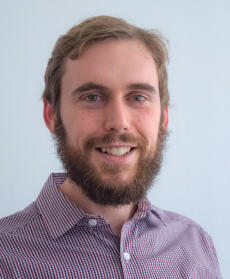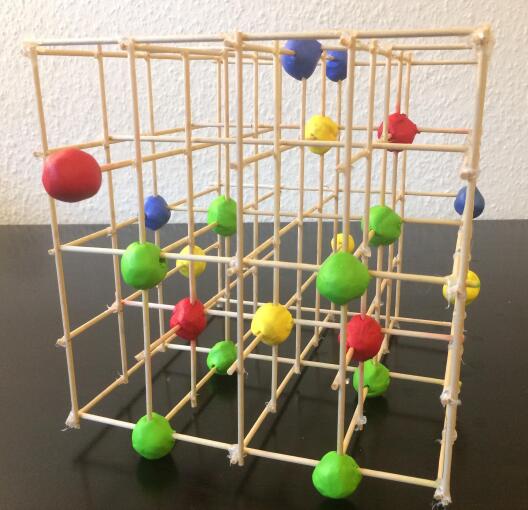Giles Gardam disproves Kaplansky's unit conjecture

The Kaplansky conjectures are three long-standing open problems on the group rings of torsion-free groups. Last week, Dr. Giles Gardam, postdoc in Mathematics Münster's topology group, announced that he succeeded to disprove the strongest of these three conjectures, namely the unit conjecture. He gives a concrete counterexample to this conjecture for a virtually abelian group with coefficients in the field of order two.
Interview
Giles, last week you held an online talk on Kaplansky's conjectures. Nearly at the end of the lecture you said "I am really happy to be able to announce today for the first time that, in fact, the unit conjecture is false." How did you feel at that moment? Were you a little bit nervous?
I was happy that I could share the announcement live with people from my research community who had tuned in for the talk, and also relieved that I hadn't messed up my timing! I think I must have been a bit nervous, not because I doubted my work but because it was a significant moment for me.
What were the reactions of the research community after the talk and the publication of your preprint?
Quite a number of people wrote with questions or good wishes - it made a much bigger splash than I had expected. A reason for the interest is that the Kaplansky conjectures relate to other problems in adjacent areas of mathematics. A factor in my underestimating the scale of the response is that the literature only reflects a tiny fraction of the attempts made. Someone wrote and said they were "one of the many that tried" to disprove the conjecture.
I also learnt after posting the preprint that although Kaplansky popularized the unit conjecture, it actually appears in Higman's doctoral thesis from 1940. What I thought was a 50-year-old question turned out to be 80!
How long have you been working on Kaplansky's conjectures? What fascinates you about them?
It's hard to quantify. I think I first put real effort in around when I first arrived in Münster, about two years ago, but I didn't really get anywhere. I came back to it about twelve months ago and worked at it off and on since then. I'm drawn to questions of this flavour, where it seems there should be a concrete counterexample but no one can find one. If you succeed, you can probably write a short and transparent paper, plus you've added to the list of weird and wonderful phenomena in maths.

How did you get the decisive idea for the counterexample: Was it more a sudden "eureka moment" or a result that gradually emerged during continuous work?
I definitely had lots of moments of small insights when away from the desk but what sticks out the most in my mind is a couple of moments where I then tried an idea out at the computer that worked and I realized "well, now I may have a little bit of a chance".
Were there any circumstances that helped you in your work?
Münster of course has a lot of great mathematicians, many of whom work on similar topics to me, and being in such an environment is incredibly helpful. I also have to say it's fantastic that we have a top-notch high performance computing (HPC) facility here. It turns out that HPC is not needed for what I did - your laptop would work just fine - but it's significant nonetheless for two reasons. The first is that knowing I have access to serious computing power if needed makes it more worthwhile to spend my time working on the problem. The second is that it pushes me to be more meticulous in my work: if I'm potentially going to do an intense computation then I'd better do it right! My bachelor's degree was in both pure mathematics and computer science, and that makes a difference.
What impact will your result have on other related conjectures and on your research area in general?
Sometimes a counterexample to one conjecture shows the way to disprove other conjectures. In my case, it's more of a proof of concept: I can't see how my counterexample could directly lead to resolving the other Kaplansky conjectures, but it shows there's nothing standing in our way, in a sense.
Now that we know the units of group rings of torsion-free groups aren't trivial, there are lots of questions to ask about them. It would also be great to get a counterexample that works for any field of coefficients but I got stuck there.
What are your further scientific plans? Will you continue working on Kaplansky's conjectures?
I have a few ideas left to play with before giving up on the other conjectures. I'd also like to get back to some other more theoretical projects for a change and spend less time at the computer!
Giles Gardam, born 1990 in Australia, is a postdoc in geometric group theory working in the Topology Group at the University of Münster since 2019. He contributes to the Cluster of Excellence Mathematics Münster and to the CRC 1442 Geometry: Deformations and Rigidity. He did his studies at the University of Sydney (undergraduate) and in Oxford (doctorate). Afterwards he was a postdoc for a year at the Technion, Israel, before visiting the Hausdorff Research Institute for Mathematics in Bonn for a trimester programme.
Links:
- Preprint: G. Gardam: A counterexample to the unit conjecture for group rings arXiv:2102.11818, 2021
- Video (Youtube): Giles Gardam - Kaplansky's conjectures, online talk at "Symmetry in Newcastle", University of Newcastle, Australia
- Personal Website: Giles Gardam
- Topology Group at Mathematics Münster

